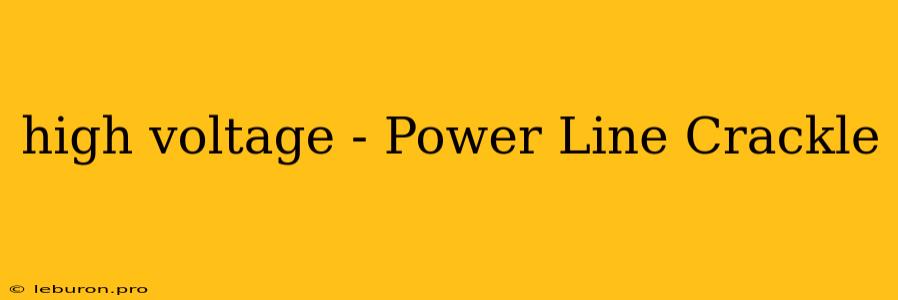The crackle of electricity, a familiar sound in the background hum of our modern world, is a constant reminder of the powerful forces at play in our power grids. This distinctive sound, often associated with high voltage power lines, is a complex phenomenon that arises from the interaction of electricity with the surrounding air. While the crackling itself may seem innocuous, it represents a vital aspect of how electricity is transmitted, and it can also be an indicator of potential problems within the system. Understanding the science behind the high voltage crackle allows us to appreciate the intricacies of our power infrastructure and the careful engineering that ensures its safe and reliable operation.
The Science Behind the Crackle:
The characteristic crackle of high voltage power lines is a consequence of the phenomenon known as corona discharge. This occurs when a strong electric field forms around a conductor carrying a high voltage. Air, typically an excellent insulator, can be broken down by a sufficiently strong electric field, causing it to become partially ionized. This ionization creates a path for current to flow through the air, resulting in the characteristic crackling sound and visible glow, often referred to as "corona".
The Role of Ionization:
The process of ionization involves stripping electrons from neutral air molecules, creating free electrons and positively charged ions. This creates a partially conductive pathway for current to flow. As electrons from the conductor jump to the air molecules, they excite the surrounding air molecules, leading to the emission of photons, producing the visible glow. The rapid fluctuations in the electrical current through the ionized air create the characteristic crackling sound.
Factors Influencing Corona Discharge:
The intensity of the corona discharge, and thus the loudness of the crackling sound, is influenced by several factors:
- Voltage: Higher voltages create stronger electric fields, leading to more intense corona discharge and a louder crackle.
- Conductor Shape: Sharp edges or protrusions on conductors concentrate the electric field, enhancing corona discharge. This is why power lines are often designed with smooth, rounded conductors.
- Air Pressure and Humidity: Lower air pressure and higher humidity contribute to a stronger corona effect. This explains why the crackle might be more pronounced in certain weather conditions.
- Spacing Between Conductors: The distance between conductors also influences the electric field strength. Closer spacing can increase the likelihood of corona discharge.
Importance of Corona Discharge:
Despite the potential for energy losses due to corona discharge, it plays a crucial role in the efficient operation of high voltage power lines.
Grounding and Shielding:
Corona discharge helps to dissipate static charges that can build up on conductors, effectively grounding the system. This prevents the accumulation of dangerous voltages and reduces the risk of electrical breakdowns.
Surge Protection:
Corona discharge can also act as a natural surge protector, dissipating excess energy from lightning strikes or other electrical disturbances. This protects equipment and infrastructure from damage.
Potential Concerns:
While corona discharge is a natural part of high voltage transmission, excessive corona can lead to problems:
Energy Loss:
Corona discharge dissipates energy into the surrounding air, leading to energy loss. This can impact the efficiency of the transmission system.
Radio Interference:
The corona discharge can generate radio frequency interference, potentially disrupting radio and television signals.
Ozone Production:
Corona discharge can also lead to the production of ozone, a gas that can be harmful to the environment.
Monitoring and Mitigation:
To ensure the safe and efficient operation of high voltage systems, engineers and technicians monitor corona activity and implement mitigation strategies.
Corona Detection:
Various techniques are employed to monitor corona discharge, including acoustic monitoring, radio frequency measurements, and visual inspection using high-speed cameras.
Mitigation Strategies:
Measures to minimize corona discharge include:
- Conductor Design: Using smooth, rounded conductors to minimize electric field concentration.
- Spacing Optimization: Adjusting conductor spacing to reduce electric field strength.
- Corona Rings: Installing metallic rings on insulators to dissipate charges and reduce corona.
Conclusion:
The crackle of high voltage power lines, a seemingly insignificant sound, reveals the complex interplay of electricity, air, and engineering. While it can indicate potential problems, it also plays a vital role in the safe and efficient operation of our power systems. By understanding the science behind the high voltage crackle, we gain a deeper appreciation for the invisible forces that power our modern world.
